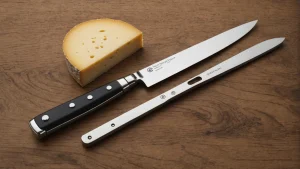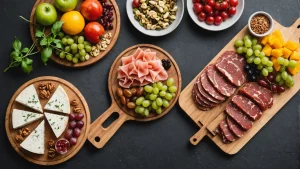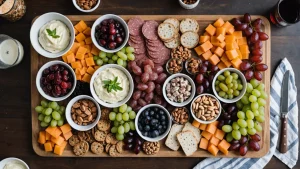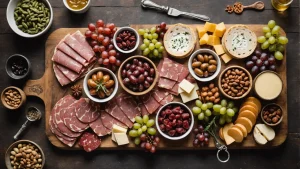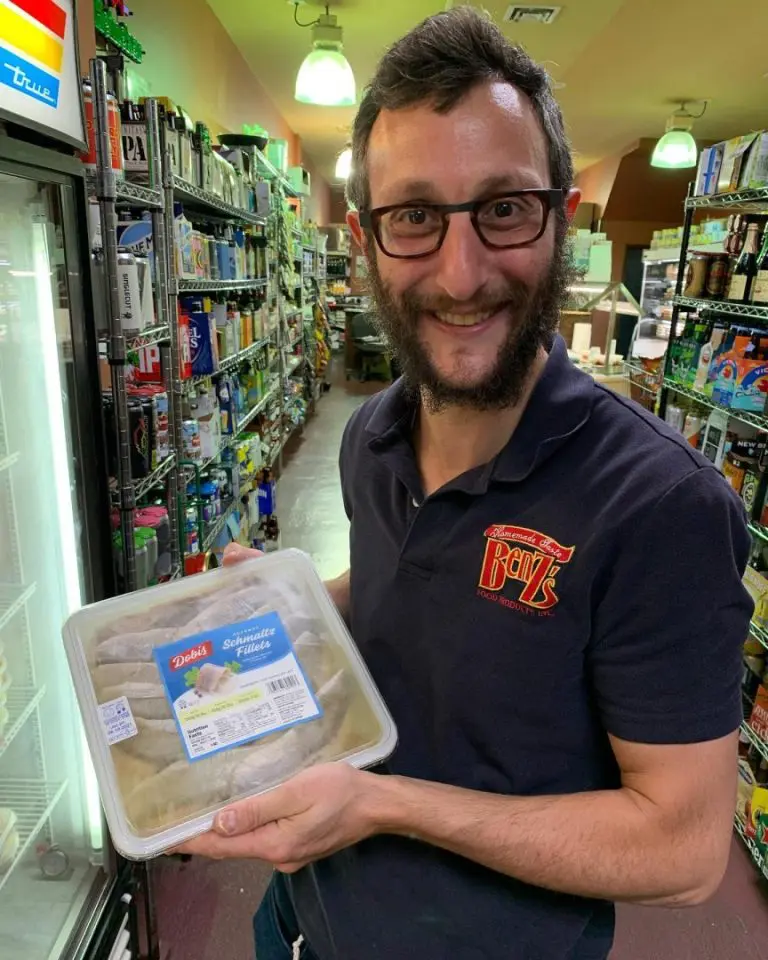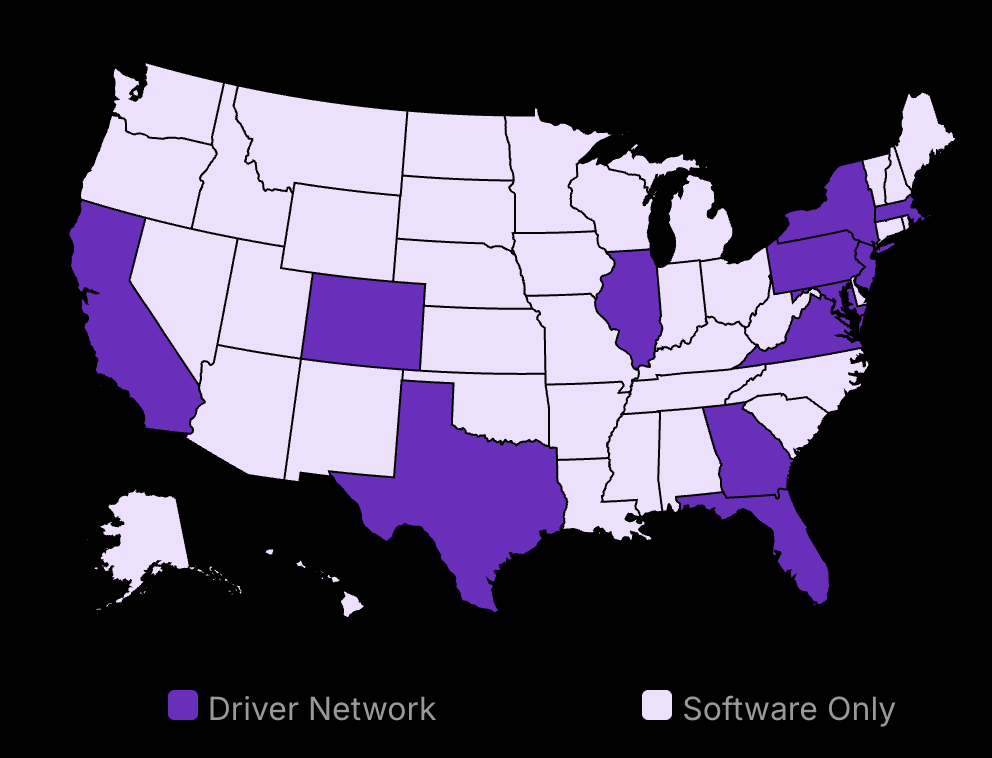In cheese retail, the knife you use can make or break your product presentation and efficiency. Different cheeses require specific tools. Soft cheese knives are perfect for delicate options like brie, whereas hard cheese knives tackle stubborn blocks like parmesan.
This guide breaks down the types of cheese knives in the world, how to choose the right ones for your business, and what features to consider for quality and comfort. Ready to optimize your cheese-cutting approach?

Metrobi is transforming charcuterie board deliveries
Specialized for charcuterie board businesses:
- Charcuterie Board-trained drivers
- Equipment for special requirements
- Peak day surge support
Types of Cheese Knives for Business Owners
Different knives suit different cheese textures.
Soft cheese knives prevent stickiness; hard cheese knives aid leverage.
Cleavers work best for semi-hard cheeses like gouda and cheddar.
Soft Cheese Knives
Soft cheese knives are designed specifically for cheeses like brie and camembert. These cheeses are high in moisture and have a softer texture. The key features of these knives include non-stick surfaces, often created using holes or perforations in the blade. This design is intended to reduce friction. As you slice through a soft cheese, air can pass through the holes and minimize the cheese sticking to the blade.
Another important aspect is the shape and angle of soft cheese knives. Many feature a slight curve. The curve aids in achieving a clean cut without dragging through the cheese and deforming it. This approach leaves the cheese looking presentable.
The design and purpose of a cheese knife often beg the question: what sets it apart from a butter knife? While a butter knife is meant for gentle spreading, a soft cheese knife, with its unique features, is crafted for slicing through delicate textures with minimal resistance. The craftsmanship behind each type of cheese knife is a lesson in form following function, making them an essential tool for cheese-centric businesses.
Hard Cheese Knives
Hard cheese knives are fundamentally different from their soft cheese counterparts. These knives are designed to tackle cheeses with much firmer textures such as parmesan and aged gouda. To break into hard cheeses, the knife needs a robust design. They often are thicker and feature sturdy handles for a secure grip. This provides the leverage necessary to break apart or wedge hard cheeses.
Length and weight play crucial roles here. A more substantial knife, one that feels balanced and weighted, aids in applying the necessary force without sacrificing control. This becomes even more apparent when you find yourself handling larger cheese blocks in a business setting. Some hard cheese knives have a double-handle, which can be particularly effective for larger and older wheels of aged cheese that need significant strength to open.
Cheese Cleavers
Cheese cleavers find their niche between the worlds of soft and hard cheeses. These knives are indispensable for slicing semi-hard cheeses like cheddar and gouda. Semi-hard cheeses require a combination of some finesse, as with soft cheeses, and clear force, like hard cheese handling. The wide blade of the cleaver makes it adept at producing uniform slices. Uniformity in slices is key for presentation, especially in gourmet catering businesses where appearance is everything.
A cheese cleaver often resembles a miniature version of a butcher’s cleaver, with a shorter, strong blade designed to slide through thicker cheese textures. The handle is typically large enough to allow a firm grip to push down, but not so unwieldy that it cannot handle more delicate operations.
These knives answer a common concern: should a cheese knife be serrated? While many cheese knives come serrated in order to cut through rinds, cleavers usually don’t. Their strength lies in a smooth blade that provides sliding cuts through cheese’s body.
This perfect balance between force and precision places cheese cleavers as a must-have in any professional cheese-focused arena.

Lower your delivery costs by 23%
How Metrobi saves you money:
- No vehicle maintenance costs
- Bulk route optimization
- Pay only for miles driven
Step-by-Step: Selecting Cheese Knives for Business
Step 1: Understand Your Cheese Selection
Selecting cheese knives begins with knowing your cheese. You canstart by analyzing the cheeses your business offers. This means identifying if you handle soft cheeses like brie, semi-soft cheeses like gouda, or hard cheeses like parmesan. Different cheeses require different cutting techniques, and consequently, different knives.
You should look at the cheese types you commonly use or plan to introduce in your country. If you’re in cheese retail, your selection might frequently change, but a core range will likely remain. You can categorize your cheeses into broad types: soft, semi-soft, semi-hard, and hard. This will guide the next steps.
Soft cheeses, like fresh mozzarella, need a knife that can handle moisture without sticking. Hard cheeses, like cheddar or asiago, require more force. Identifying these needs tells you what type of knives you’ll require.
Step 2: Evaluate Knife Types
Once you know your cheese types, tie them to specific knife features. This step is about matching knives with cheese textures for optimal service.
Each cheese type needs special knife features. For soft and semi-soft cheeses, opt for knives with holes or specially coated blades that reduce sticking. For hard cheeses, a strong, sharp blade provides the necessary force and safety.
Soft and sticky cheeses are easier to cut with perforated or hollow knives. These designs help the knife glide through the cheese without sticking. Harder cheeses may be managed with heavy-duty knives, like cleavers, which can slice through without breaking the cheese apart.
Step 3: Consider Business Needs
Now, you should focus on what your business needs out of a cheese knife. This goes beyond just functionality—presentation and volume matter too.
You can calculate how much cheese is cut daily. High volumes mean possible wear and tear, pushing the need for durable knives. If you only serve cheese occasionally, you might prioritize aesthetics over ruggedness.
If client presentation is key, then more decorative knives or ones that create clean and consistent cuts are ideal. Cheese displays must be visually appealing as they are a direct reflection of your cheese business.
Essential Cheese Knife Features to Look For
Blade Material and Quality
Stainless steel and ceramic are the primary materials used in cheese knives. Stainless steel is known for its durability. It’s a top choice for cheese knives because it resists rust and maintains a sharp edge. This is essential when cutting through different cheeses, from soft Brie to hard parmesan. Stainless steel is often praised for its ability to withstand repeated use without compromising performance, making it ideal for businesses handling large volumes of cheese.
Ceramic knives, on the other hand, offer non-reactivity. This feature is particularly important when dealing with acidic or odorous cheeses. Ceramics don’t interact with cheese to alter its taste or aroma. It is also lighter than metal, which some users find easier to handle. However, ceramic blades require more care as they can be more prone to chipping.
Choosing between stainless steel and ceramic ultimately comes down to the setting in which the knife is used and personal preference. You should consider if your business needs the durability of stainless steel knives or the special non-reactive properties of ceramic.
Handle Comfort and Grip
When selecting a cheese knife, the handle design should not be overlooked. Ergonomic designs are vital for professionals cutting cheese for long periods. The right handle reduces fatigue and strain on the user’s hand and wrist. Materials like rubber or textured plastic provide a firm grip to prevent slipping, even when the handle is wet. This improves safety and efficiency.
For businesses, ergonomic knives translate to higher productivity and reduced risk of accidents. Handles that fit comfortably also allow the user to exert precise control over the blade’s movement. This precision is crucial for creating aesthetically pleasing cheese cuts.
Experts from Sharp Branding Tools mention that an ergonomic handle, along with a high-quality blade, enhances ease of use and durability. They suggest that features like textured grips can prevent the knife from slipping. This allows for both accurate cuts and a secure, steady grip that inspires confidence.
Balance and Weight
A well-balanced knife significantly increases its ease of use. It allows for better control during cutting, especially for commercial use. The right weight helps maintain cutting precision over long sessions. Heavier knives may provide more leverage, helpful in cutting through hard cheese varieties. On the other hand, lighter knives might offer a more delicate touch, ideal for softer cheeses.
Balance influences how comfortable and effective a knife is when performing repetitive cuts. For instance, a poorly balanced knife can tire the user more quickly and may produce inconsistent slices. A well-balanced knife gives the user better control, enabling cleaner cuts and enhancing the presentation of cheese portions.
Opinions are mixed on whether cheese knives should be lightweight or heavy who emphasize choosing based on cheese texture. They point out features they choose such as sharp, wide blades and thick handles when selecting knives for hard cheeses, highlighting how balance directly affects their functionality.
By understanding these features, business owners can choose cheese knives that enhance their operations, offering durability, comfort, and control.
Best Cheese Knives for Retailers: A Buyer’s Guide
Recommended Brands and Models
When choosing cheese knives for retail, certain brands consistently deliver top-tier quality. Brands like Wüsthof and Victorinox are widely acclaimed. Wüsthof offers models like the Gourmet Cheese Knife, which is well-suited for soft cheeses. For hard cheeses, the Wüsthof Classic Parmesan Knife is recommended for its sturdy construction. Victorinox, known for precision, offers a wide blade knife that excels with semi-hard cheeses like cheddar. Seeking innovative charcuterie board concepts? Learn how to elevate your board with cheese knives perfect for every cheese type, ensuring a remarkable and stylish presentation.
Choosing the right model goes beyond brand loyalty. For example, soft cheese knives often feature holes in the blade to reduce sticking, essential for cheeses like brie or Camembert. For firmer varieties, opt for models with reinforced handles and thick blades, ensuring controlled cuts through hard cheese types like parmigiano-reggiano. Chefs and retailers often choose a variety selection of models to accommodate the wide range of cheese textures they encounter, laying the foundation for a comprehensive cheese service.
Keeping essentials like a soft cheese knife, a hard cheese knife, and a cleaver ensures that you can handle pretty much any cheese your own cart or business features. This setup not only enhances your cheese presentation, but it also allows you to cater effectively to customer preferences. Choosing the right charcuterie board accessories is crucial for elevating your presentation and satisfying your clientele’s diverse tastes.
Cost vs. Value
Balancing cost with value is often a significant consideration for business owners. Investing in high-quality knives might seem steep initially but provides long-term benefits that cheaper alternatives might not. You can consider how frequently you’ll use these knives. If cheese is a major part of your product offering, purchasing durable, premium knives reduces the need for frequent replacements. Plus, the efficiency in cutting not only saves time but also delivers a better customer experience.
You should consider also the potential for discounts on bulk purchases. Established knife brands may offer packages for retailers, aimed at reducing costs while still delivering quality. When making your decision, align your investment with the volume of cheese processed in your business. A high-traffic cheese shop may require more substantial investment, while a lower-volume business might prioritize specific items or high-usage models.
Cost considerations don’t just encompass the upfront payment. You should consider maintenance, replacement, and potential lost business from poor presentation or performance. Spending a bit more now may lead to savings and added value in the long run.
Retailers can reduce costs by exploring bulk purchases. It’s common for reputable brands to offer incentives when buying wholesale. Not only does this cut down the cost per unit, but it also allows businesses to standardize their tools. Standardization helps in training staff more effectively, ensuring consistent quality of service. By asking suppliers for deals aimed at business buyers, you can often find financially advantageous agreements that continue to respect your quality benchmarks.
Maintenance and Care
Proper maintenance of cheese knives extends their lifespan and preserves performance. Cleaning after each use is crucial. Warm soapy water works best, and ensure knives are thoroughly dried to avoid rust. Storing knives in a dedicated block or magnetic strip can also prevent dullness and accidental damage.
Regular sharpening is another key part of maintenance. Cheese knives, especially those used for hard cheeses, should be sharpened every few months. This frequency can vary depending on usage. Not all sharpening tools are equal. For high-carbon steel models, traditional whetstones are ideal, while ceramic knives are best sharpened with specific tools.
By following a set regular maintenance schedule, you not only enjoy a consistently great cutting experience but also extend the functional life of your investment. You should ensure that your staff understand these maintenance routines, potentially incorporating them into training programs for new employees.
You can begin by wiping the knife blade clean right after use to prevent cheese residue, which can harden and stain. A damp cloth is often sufficient. For a deeper clean, submerge in soapy water, but avoid prolonged soaking. Always you should dry completely with a soft towel to avoid moisture damage.
You should establish a schedule for sharpening. Every 3-6 months is a good starting point, increasing frequency with heavy usage. For most, enlisting professional sharpening services assures precise edge maintenance. If self-sharpening tools are used, follow instructions carefully to avoid damaging the blade.
How Many Cheese Knives Do I Need?
For businesses, at least three types of cheese knives are recommended. A soft cheese knife, a hard cheese knife, and a cleaver for semi-hard cheeses cover the majority of your orders. This selection ensures versatility without excess. If your business focuses on specific types, you might adjust this list. Instead of an all-purpose knife, select those that align with your typical cheese offerings. Choosing the right charcuterie equipment, including cheese knives, is crucial for creating a bespoke experience on your charcuterie boards.
Are cheese knives necessary? Absolutely. They prevent damage that regular kitchen knives can cause to both the cheese and plate presentation. However, if just starting or on a budget, you should prioritize the ones that fit your main offerings. For temporary alternatives, a clean paring knife can suffice for soft cheeses but shouldn’t replace specialized options long-term. Discover the distinctions between a Charcuterie Board and a Cutting Board, ensuring you’re equipped with the right tool for every culinary task, including perfect cheese plating.
Ensuring you have the right tools directly impacts your product’s presentation and customer satisfaction, establishing you as a trusted source for cheese lovers.
Choose the Right Cheese Knife to Elevate Your Business
Picking the right cheese knife can make or add your cheese offerings. Soft and hard cheese knives excel in different contexts, and understanding your needs helps avoid mismatches. Balancing quality, comfort, and value ensures wise decisions.
A well-chosen knife reflects your business’s attention to detail and improves customer experience. Next, assess your current collection of cheese tools. You can compare them to what you’ve learned to spot any gaps. You can consider investing in recommended brands to enhance your setup.
How does your choice of cheese knives impact customer satisfaction?
Elevate your cheese presentation one slice at a time.




